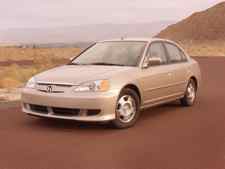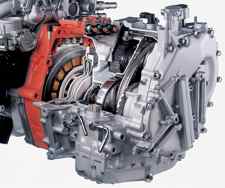

TechnoFILE is copyright and a registered trademark © ® of
Pandemonium Productions.
All rights reserved.
E-mail us Here!

Hybrid Honda Helps Do Civic DutyGas Sipper A Great Day Tripperby Jim Bray The Hybrid automobile has definitely arrived, if you don’t mind paying the price. Honda’s Insight was the first “mainstream” hybrid car to hit the market, a technological tour de force that blended the gas internal combustion engine with an electric motor to provide extra oomph. Unfortunately, the Insight was mostly impractical except as a novelty or as a commuter car, thanks to its two seat configuration and lack of storage space. That was “Generation One.” Generation Two is a real, practical four door sedan that’s basically a standard Honda Civic enhanced with new technology to make it more miserly. The new Civic Hybrid joins Toyota’s Prius in the hybrid “real car” field, but without the Prius’ unusual looks: the Civic Hybrid looks virtually the same as the garden variety Civic, except for some subtle changes such as a new grille, a cute little spoiler on the trunk lid, and an antenna mounted in the middle of the roof’s front section like a single eyebrow. Inside, it looks like a regular Civic (click here for our Civic review), too, except for the dashboard and the fact that the rear seat doesn’t fold down (the battery pack’s stored between the seat and the smaller - but still spacious - trunk). The seats are comfortable for four, okay for five (thanks in great part to the flat floor that gets rid of the traditional hump down the center of the floor) and you’re treated to all the creature comforts you need - from a decent (though not outstanding) AM/FM/CD stereo, power everything, automatic climate control, cruise control, and manually adjustable seats that are easy on the bum. You also get remote keyless entry, tilt steering wheel, and a good assortment of storage bins - though for some reason there are no cup holders in the rear. And that’s about it for nits at which to pick: no rear cupholders! Okay, the vent control knob should be reversed so the driver can see its labels more easily, but that’s also extremely minor. But it’s the performance that makes this Civic unique, from its hybrid configuration to its brand new CVT (continuously variable transmission) that takes what could be considered a rather anemic package and pushes it into the realm of eminently practical. The Hybrid is powered by Honda’s second generation Integrated Motor Assist (IMA) system that includes a new 1.3 liter i-DSI inline 4-cylinder gasoline engine, “intelligent” i-DSI (Dual & Sequential Ignition) lean burn combustion technology with two spark plugs per cylinder and Honda’s VTEC controlled Cylinder Idling System. The system is rated as ULEV (ultra low emissions vehicle), which is acceptable even to the tree huggers in California (or, at least, as acceptable to them as ANY car not powered by sunlight or clean thoughts!) 
The 1.3 liter gas engine (as opposed to the 1.7 liter of the “real” Civic) is rated at a mere 85 horsepower @ 5700 and 87 lb.-ft of torque @ 3300 rpm. Add the little permanent magnet electric motor that’s attached to the engine, however, and those figures jump 93 to horses @ 5700 and 105 torquey things @ only 3000 rpm. While still modest, in the real world - and coupled to the CVT transmission – it creates a car that can easily keep up with city traffic, even on the freeway. And that isn’t the end of the story. We had the Hybrid for a week and took the opportunity to put it through a “torture test” that included rural driving on every type of highway short of gravel and dirt. We began in the foothills of the Rocky Mountains, went right into the mountains themselves (including a couple of passes and summits that could have been designed to test cars’ mettle), and back on hilly multilane freeway. The Hybrid performed beautifully; even in cruise control it held its speed well, including on fairly steep uphill sections of the highway. When not in cruise the care glides along beautifully, and there's enough poop to propel you along with no problems at all, even (as mentioned) when going uphill. In fact, despite its modest specs the Hybrid will still accelerate up hills. At the risk of being accused of whatever you might want to accuse me of: I am in awe. This Civic Hybrid is an amazing vehicle, wonderfully designed and beautifully executed. The first thing you notice upon starting the vehicle is that it’s so quiet you almost want to start it again. Sure, there are other cars like that, but I can’t think of any in the “econobox” class. And the quiet extends to driving. This car glides along the road so smoothly and silently it almost feels frictionless except for the telltale sound of the tires on the road. There’s little wind noise unless the wind is really a-howlin’ and the only time you hear engine noise is when you prod those tiny horses onward and upward - at which time you’re treated to an unusual kind of whining that’s unlike anything I’ve heard in a vehicle before. It isn’t an unpleasant whine (and perhaps “whine” isn’t the best term, but it certainly isn’t a growl or a howl) but it’s definitely noticeable when the Civic Hybrid is being hustled along in “I think I can, I think I can” mode. To be fair, this little car is so slick a performer I should probably refer to the above as “I know I can” mode…. Anyway, the second thing you notice is that, thanks to the CVT transmission, there are no shifts. None. Even with a conventional automatic transmission, even in luxury cars, you can always sense the shifts no matter how subtle or controlled they are. But the CVT doesn’t shift. It’s almost as if there’s only one gear (the correct one), and regardless of how hard you mash the gas pedal into the floor there are no changes to the gear. Instead, you get changes in engine rpm: step hard on the gas and the revs jump accordingly until you ease off again. This takes getting used to, but now that I’ve messed around with it for a week I’m convinced that - technology and pricing willing - all automatic transmissions should work like this. It isn’t quite enough to change me from a manual transmission maniac to an auto-maton, but I never thought I’d ever rave about an automatic transmission before the CVT. Here’s how Honda describes the CVT: “The CVT system works by varying the position of a high-strength steel belt between two metal cones under high pressure – one cone connects to the power input of the transmission and one cone connects to the power output side of the transmission. Through various guides within the transmission, the belt can occupy any position between the two cones to create the most suitable gear ratio for any vehicle speed and throttle input. The CVT is completely automatic and virtually provides an infinite range of gear ratios for smooth, stepless shifting, combined with maximum efficiency and performance. The CVT also works in conjunction with the unique "idle stop" feature, avoid using gas while at red lights or idling in traffic. The engine automatically re-starts when the brake pedal is released.” Speaking of Idle Stop, this feature is activated or bypassed by a button labeled “ECON” on the dash, beside the air conditioning button. It works very well, but if you have the climate control system set to automatic it shuts it off, too, which on a really hot day can lead to the alternate baking and cooling of the passengers. If you have the fan set to manual the air conditioning shuts off when the idle stop is working, but the fan keeps going. Another minor complaint: as with some other Hondas, when you put the window defoggers on the air conditioning comes on to help it, but when you shut off the defoggers the A/C doesn’t shut off. Honda, of all people, should fix this oversight. When driving the Hybrid you have to learn a new style. For example, if you’re used to downshifting an automatic to take advantage of engine braking on hills or when decelerating, forget it: there’s no downshifting with a transmission that never shifts, so you’ll have to use the brakes. In use, the electric motor feels kind of like a little turbocharger, in that it provides extra kick when it’s needed. On our mountain trip it was needed a lot, yet we never, ever ran the battery down even on long, long uphill sections - and the car’s built in intelligence seems to start that battery pack a-chargin’ before it reaches bottom and panic sets in on the part of the driver. You can watch the process via the digital instrument on the dashboard; when the electricity is being called upon a little blue gauge shows how much it’s being strained (with the battery charge gauge dropping appropriately) and when you ease off the gas or start braking a green gauge shows the amount of charging being performed. This is a nifty display; so nifty you can forget to keep your eyes on the road ahead of you you’re so engrossed in the “gee whiz” aspect of the Hybrid. The rest of the instrument panel is pretty conventional and mostly analog, except for a graph below the odometer whose purpose I couldn’t fathom (my tester had no owner’s manual), though it may have something to do with tracking fuel economy. The instruments are colored in a pretty blue (my wife says it’s Periwinkle) that’s easy to read and easy on the eyes. All the controls fall easily to hand, though I would have liked to see the stereo about a quarter of an inch closer to the driver (how’s that for picking nits?), and the layout is classic Honda efficiency and simplicity. The driver also gets a large and well placed left foot rest, something every car needs, and the steering wheel is very comfortable for all day driving. Oh, my tester came with a lovely “Flourite Silver Metallic” paint job that, depending on how the light hit it, looked either silver or a pretty blue. Nicely done. The US specs rate the Honda Civic Hybrid at 48 MPG city and 47 highway with the CVT (a 5 speed manual transmission is also available, EPA rated at 46 mpg city 51 mpg highway). So is this a perfect car, just right for this “environmentally enlightened” age? Well… As much as I fell in love with this little car and as much as its technology blew me away, I wonder if the price is worth the premium. According to Honda’s US Web site, a regular 2002 Honda Civic LX with automatic transmission and mostly comparable features lists for $17,239.00 US and EPA rated at 30/38 mpg. Compare that with the Hybrid’s “as tested” price of approximately $21,221.00 US to get that extra 10-18 mpg and you’ll have to decide if it’s worth the premium you’ll pay over the life of the car. It probably is if you’re a tree hugger or just get off on nifty technology. But from a strict economics standpoint, well, I’m just not sure. But it sure is a terrific car and I take my hat off to Honda for pulling it off! Jim Bray is a member of the Automobile Journalists Association of Canada. His columns are available through the TechnoFile Syndicate. |
Support TechnoFile via Paypal |
TechnoFILE's
E-letter We're pleased to offer our FREE private, subscription-based private E-mail service. It's the "no brainer" way to keep informed. Our Privacy Policy |